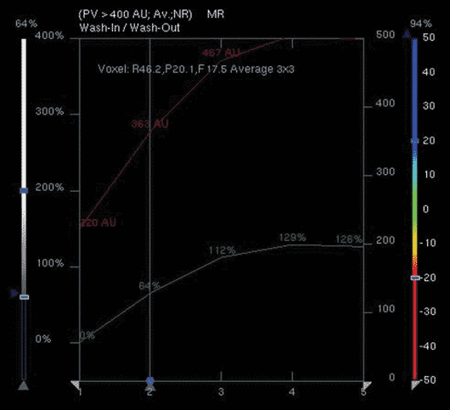Benign inflammatory lesion of the reconstructed breast: a diagnostic challenge
A 40-year-old woman presented to our hospital with a painless right axillary mass with duration of two months. Her history included stage IIA right breast cancer diagnosed 18 months prior. She underwent mastectomy and sentinel lymph node sampling followed by immediate transverse rectus abdominis muscle reconstruction. The tumor was a multifocal, moderately differentiated infiltrating lobular carcinoma with extensive ductal carcinoma in situ, and nonsentinel lymph node from the right axillary tail of the breast was positive for macrometastasis. The tumor was ER-positive, PR-positive and HER-2/neu-negative. She received adjuvant chemotherapy with four cycles of dose dense doxorubicin and cyclophosphamide and is currently on adjuvant hormonal therapy with tamoxifen.
On physical examination, she had a single mobile, nontender, 2 cm × 1.5 cm palpable right axillary lymph node with no palpable lesions in the reconstructed right breast. She underwent a core biopsy of the right axillary lymph node that was consistent with recurrence of disease. A PET/CT scan revealed a 1.8-cm × 1.2-cm right axillary lymph node with a standardized uptake value of 2.4 and multiple foci of hypermetabolism in the reconstructed right breast with a standardized uptake value range of 1.5 to 1.9. There was no evidence of systemic metastatic disease. An MRI of the breast demonstrated a peripheral nodular enhancing oval area in the right breast consistent with fat necrosis and a right axillary node 3 cm × 1.5 cm × 2 cm. An ultrasound guided core biopsy of the right reconstructed breast showed inflammatory response, presence of histiocytes, and there was no evidence of malignancy.
At the time of writing, she is scheduled for right axillary lymph node dissection followed by taxane-based chemotherapy, radiation, ovarian suppression with a gonadotropin-releasing hormone agonist and an aromatase inhibitor.
|
|
| |
|
Photos courtesy of M Ghesani |
CASE DISCUSSION
Although postoperative remodeling can result in mild hypermetabolic activity in the surgical bed — which can persist for a few months, sometimes up to one year — PET/CT scanning in this patient was performed 18 months following surgery. In this setting, uncomplicated postoperative remodeling would be unlikely to demonstrate multifocal hypermetabolism in the reconstructed breast. With recurrence of disease in the axillary node, there was an overwhelming concern for malignancy in the reconstructed breast. An MRI of the reconstructed breast revealed fat necrosis, corresponding with hypermetabolic lesions on PET/CT.
Fat necrosis following TRAM reconstruction is a common complication with an incidence ranging from 5% to 26%. It is a benign noninfectious, inflammatory process of the adipose tissue attributed to the poor blood supply in the periphery of soft tissue flap. The appearance of fat necrosis can mimic tumor recurrences both clinical and radiologically. This is one of the benign processes, which is known to demonstrate 18F-fluorodeoxyglucose uptake on PET/CT imaging. On MRI imaging, fat necrosis is characterized by fatty signal intensity mass, often containing a fat-fluid level that exhibits variable enhancement following administration of gadolinium contrast material. The presence of central fat signal intensity is the key to differentiating fat necrosis from tumor recurrence, as breast cancers do not contain central fat.
Munir Ghesani, MD, is Associate Clinical Professor of Radiology at Columbia University College of Physicians and Surgeons and Attending Radiologist at St. Luke’s-Roosevelt Hospital Center.
Vamsee Torri, MD, is a Fellow in the Division of Hematology-Oncology at St. Luke’s Roosevelt Hospital Center.
Lynn Ladesky, MD, and Rosna Mirtcheva, MD, are both attending radiologists at St. Luke’s-Roosevelt Hospital Center.
Neil Gupta, MD, is a Resident in Radiology, St. Luke’s-Roosevelt Hospital Center.
For more information:
- Devon RK, Rosen MA, Mies C, et al. Breast reconstruction with a transverse rectus abdominis myocutaneous flap: spectrum of normal and abnormal MR imaging findings. Radiographics. 2004;24:1287-1299.
- Metser U, Miller E, Lerman H, et al. Benign nonphysiologic lesions with increased 18F-FDG uptake on PET/CT: characterization and incidence. Am J Roentgenol. 2007;189:1203-1210.








